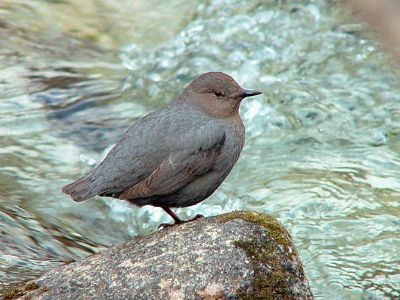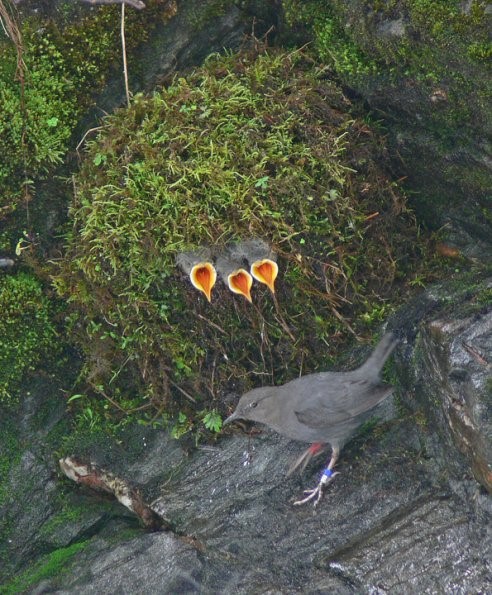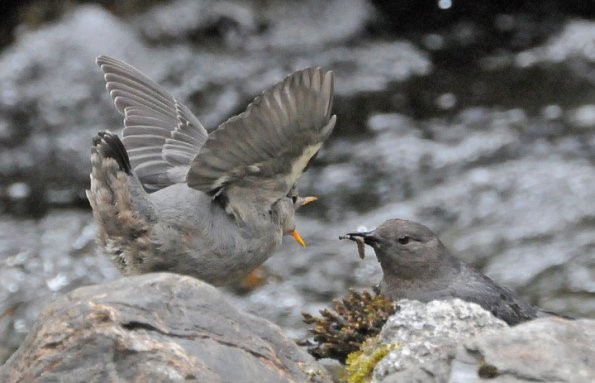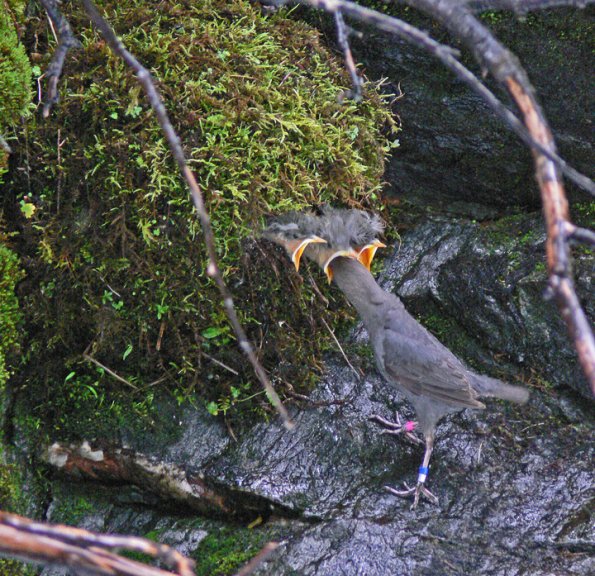Life History and Reproduction
MIGRATORY VS. RESIDENTIAL
Multiple studies and observations have been conducted on the
American Dipper due to its unique
partial-migratory activity. Unlike many other bird species, the
American Dipper usually remains residential to their original
territory only occasionally moving to near-by streams and rivers
from time to time based on food availability and stream
turbulence (BirdWeb 1999). Some American Dipper populations
consist of individuals who are either migratory or sedentary/residential (Mackas
et al. 2010). This
unique characteristic of the American Dipper has res ulted
in a number of theories. Some theories suggests that migratory
dippers are at an advantage because they are able to minimize
any risk of predation to their nest and offspring at higher
elevations, which results in more successful reproduction
periods and more offspring (Mackas et al. 2010). However,
according to two different studies, (Mackas et al. 2010;
Middleston et al. 2006) migratory American Dipper individuals
that bred at higher elevations ultimately produced offspring in
worse condition. Due to these findings, it is said that the
migratory dipper offspring are less likely than the residential
dipper offspring to survive until the following year (Mackas et
al. 2010). That being said, the American Dipper tends to be
more sedentary than migratory with around 74% of the population
remaining residential according to a more recently conducted
study (Middleton et al. 2006). Importantly noted,
offspring produced at different elevations has not shown to
actually produce better quality offspring (Mackas et al. 2010).
ulted
in a number of theories. Some theories suggests that migratory
dippers are at an advantage because they are able to minimize
any risk of predation to their nest and offspring at higher
elevations, which results in more successful reproduction
periods and more offspring (Mackas et al. 2010). However,
according to two different studies, (Mackas et al. 2010;
Middleston et al. 2006) migratory American Dipper individuals
that bred at higher elevations ultimately produced offspring in
worse condition. Due to these findings, it is said that the
migratory dipper offspring are less likely than the residential
dipper offspring to survive until the following year (Mackas et
al. 2010). That being said, the American Dipper tends to be
more sedentary than migratory with around 74% of the population
remaining residential according to a more recently conducted
study (Middleton et al. 2006). Importantly noted,
offspring produced at different elevations has not shown to
actually produce better quality offspring (Mackas et al. 2010).
So why does the American Dipper population have some individuals who tend to migrate even though the offspring produced in these migratory areas tend to be in worse condition and there are no offspring quality differences? Further investigation has found that migration has evolved in the American Dipper once all sedentary populations realized there was too high a competition for such limited resources. This resulted in a number of individuals to seek other areas for breeding opportunities located away from their initial range (Gillis et al. 2008).
THE MATING "RITUAL"
The American Dipper’s preference
for turbulent moving streams and rivers is important for helping to
protect its nest (Montana Outdoors 2003). The male and female
dippers come together each spring at the nesting sight to reproduce
(Montana outdoors 2003). During the mating season, the male dipper
begins the mating “ritual” (Animal Diversity Web 2001). This
consists of an intricate performance intended to impress and attract
the attention of a female dipper. The ritual begins with the male
stretching his neck upward while keeping his wings partially spread
and pointed downward. In addition, the male keeps his bill held
vertically while flashing his bright white eyelids to show
courtship. He then proceeds to sing and strut around in front of the
female (Animal Diversity Web 2001). If the female dipper is
impressed by the male’s song and dance performance, together the two
begin to perform together and they eventually end the mating ritual
by touching their breasts together (Animal Diversity Web 2001).
its nest (Montana Outdoors 2003). The male and female
dippers come together each spring at the nesting sight to reproduce
(Montana outdoors 2003). During the mating season, the male dipper
begins the mating “ritual” (Animal Diversity Web 2001). This
consists of an intricate performance intended to impress and attract
the attention of a female dipper. The ritual begins with the male
stretching his neck upward while keeping his wings partially spread
and pointed downward. In addition, the male keeps his bill held
vertically while flashing his bright white eyelids to show
courtship. He then proceeds to sing and strut around in front of the
female (Animal Diversity Web 2001). If the female dipper is
impressed by the male’s song and dance performance, together the two
begin to perform together and they eventually end the mating ritual
by touching their breasts together (Animal Diversity Web 2001).
OFFSPRING
Usually the American Dipper lays two to five white colored eggs,
which the female broods for around a 16-day incubation period
(Montana Outdoors 2003). Once the baby dippers hatch, they remain in
the nest for an average of 24 days. In the meantime, the male dipper
helps the female dipper in feeding the baby dippers (Montana
Outdoors 2003). After the 24-day period following the offspring
hatching, the young offspring are able to leave the nest and swim
and dive for their own food (BirdWeb 1999). Typically the females
will produce two broods a year.

